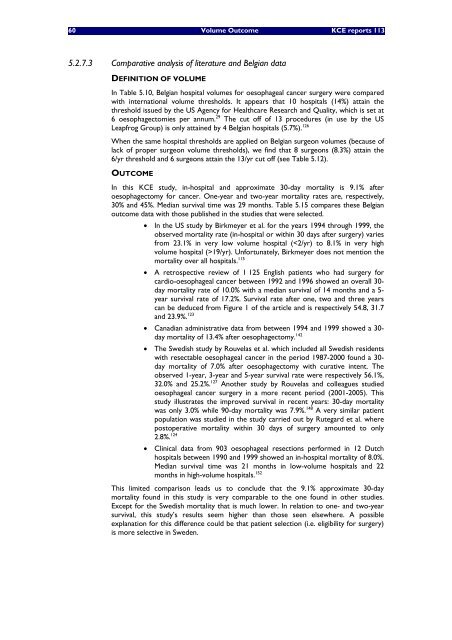Het volume van chirurgische ingrepen en de impact ervan op ... - KCE
Het volume van chirurgische ingrepen en de impact ervan op ... - KCE
Het volume van chirurgische ingrepen en de impact ervan op ... - KCE
Create successful ePaper yourself
Turn your PDF publications into a flip-book with our unique Google optimized e-Paper software.
60 Volume Outcome <strong>KCE</strong> reports 113<br />
5.2.7.3 Comparative analysis of literature and Belgian data<br />
DEFINITION OF VOLUME<br />
In Table 5.10, Belgian hospital <strong>volume</strong>s for oes<strong>op</strong>hageal cancer surgery were compared<br />
with international <strong>volume</strong> thresholds. It appears that 10 hospitals (14%) attain the<br />
threshold issued by the US Ag<strong>en</strong>cy for Healthcare Research and Quality, which is set at<br />
6 oes<strong>op</strong>hagectomies per annum. 29 The cut off of 13 procedures (in use by the US<br />
Leapfrog Group) is only attained by 4 Belgian hospitals (5.7%). 126<br />
Wh<strong>en</strong> the same hospital thresholds are applied on Belgian surgeon <strong>volume</strong>s (because of<br />
lack of pr<strong>op</strong>er surgeon <strong>volume</strong> thresholds), we find that 8 surgeons (8.3%) attain the<br />
6/yr threshold and 6 surgeons attain the 13/yr cut off (see Table 5.12).<br />
OUTCOME<br />
In this <strong>KCE</strong> study, in-hospital and approximate 30-day mortality is 9.1% after<br />
oes<strong>op</strong>hagectomy for cancer. One-year and two-year mortality rates are, respectively,<br />
30% and 45%. Median survival time was 29 months. Table 5.15 compares these Belgian<br />
outcome data with those published in the studies that were selected.<br />
• In the US study by Birkmeyer et al. for the years 1994 through 1999, the<br />
observed mortality rate (in-hospital or within 30 days after surgery) varies<br />
from 23.1% in very low <strong>volume</strong> hospital (19/yr). Unfortunately, Birkmeyer does not m<strong>en</strong>tion the<br />
mortality over all hospitals. 115<br />
• A retrospective review of 1 125 English pati<strong>en</strong>ts who had surgery for<br />
cardio-oes<strong>op</strong>hageal cancer betwe<strong>en</strong> 1992 and 1996 showed an overall 30day<br />
mortality rate of 10.0% with a median survival of 14 months and a 5year<br />
survival rate of 17.2%. Survival rate after one, two and three years<br />
can be <strong>de</strong>duced from Figure 1 of the article and is respectively 54.8, 31.7<br />
and 23.9%. 123<br />
• Canadian administrative data from betwe<strong>en</strong> 1994 and 1999 showed a 30day<br />
mortality of 13.4% after oes<strong>op</strong>hagectomy. 142<br />
• The Swedish study by Rouvelas et al. which inclu<strong>de</strong>d all Swedish resid<strong>en</strong>ts<br />
with resectable oes<strong>op</strong>hageal cancer in the period 1987-2000 found a 30day<br />
mortality of 7.0% after oes<strong>op</strong>hagectomy with curative int<strong>en</strong>t. The<br />
observed 1-year, 3-year and 5-year survival rate were respectively 56.1%,<br />
32.0% and 25.2%. 127 Another study by Rouvelas and colleagues studied<br />
oes<strong>op</strong>hageal cancer surgery in a more rec<strong>en</strong>t period (2001-2005). This<br />
study illustrates the improved survival in rec<strong>en</strong>t years: 30-day mortality<br />
was only 3.0% while 90-day mortality was 7.9%. 148 A very similar pati<strong>en</strong>t<br />
p<strong>op</strong>ulation was studied in the study carried out by Rutegard et al. where<br />
post<strong>op</strong>erative mortality within 30 days of surgery amounted to only<br />
2.8%. 124<br />
• Clinical data from 903 oes<strong>op</strong>hageal resections performed in 12 Dutch<br />
hospitals betwe<strong>en</strong> 1990 and 1999 showed an in-hospital mortality of 8.0%.<br />
Median survival time was 21 months in low-<strong>volume</strong> hospitals and 22<br />
months in high-<strong>volume</strong> hospitals. 152<br />
This limited comparison leads us to conclu<strong>de</strong> that the 9.1% approximate 30-day<br />
mortality found in this study is very comparable to the one found in other studies.<br />
Except for the Swedish mortality that is much lower. In relation to one- and two-year<br />
survival, this study’s results seem higher than those se<strong>en</strong> elsewhere. A possible<br />
explanation for this differ<strong>en</strong>ce could be that pati<strong>en</strong>t selection (i.e. eligibility for surgery)<br />
is more selective in Swed<strong>en</strong>.

















